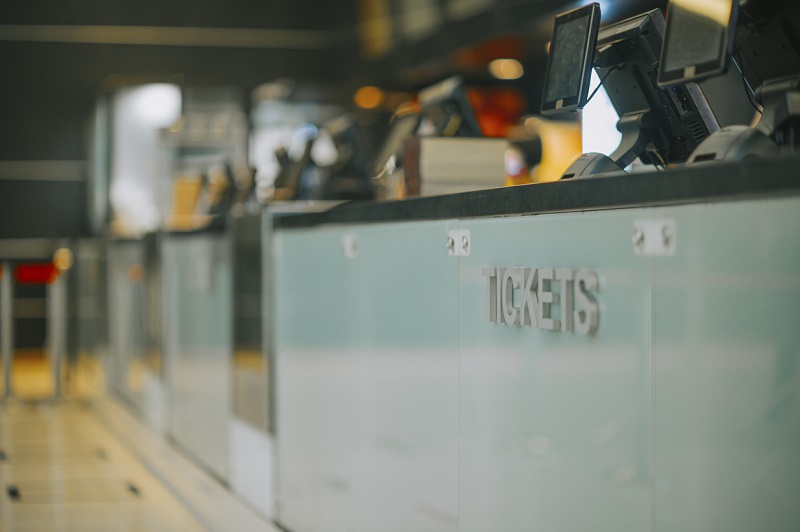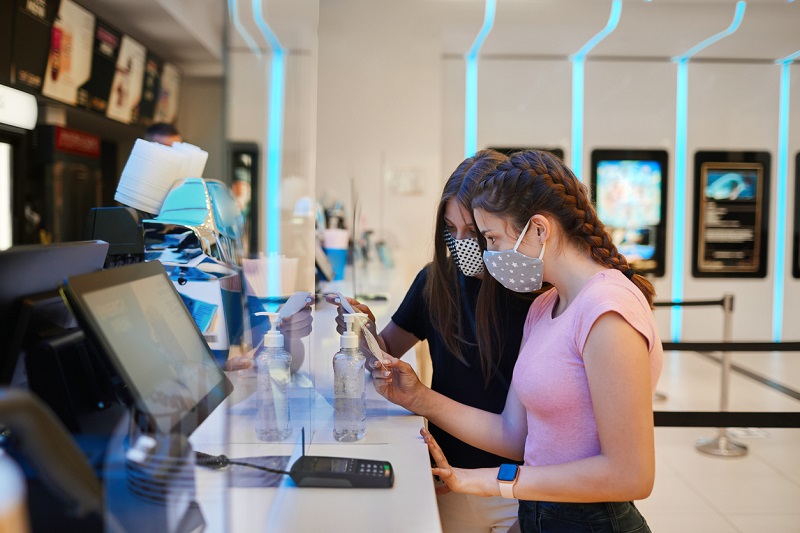Even prior to the COVID pandemic, movie theater ticket kiosks were becoming a common sight. Now, as movie fans begin to return to theaters to watch their favorites on the big screen, the adoption of these ticket kiosks has never been more essential, for both the fans, and the businesses behind the theaters.
What is a movie theater ticket kiosk?
A movie theater ticket kiosk automates printing and payment for movie tickets. Additionally, they can also handle changes to a ticket such as a different seat, movie or time slot.

Why are movie ticket kiosks becoming more popular?
With COVID-19, movie theaters need to lower costs while maintaining the same level of efficiency. Kiosks allow them to continue to operate while lowering the high overhead that comes with having the theatre open. In addition, kiosks allow staff to be repurposed for more pertinent tasks such as customer service or maintaining the theatre while the kiosk handles ticket sales.
Benefits of Movie Theater Ticketing Kiosks
Movie theater kiosks have many benefits, most of which are centered around the customer experience and a reduction in overhead costs.
Self-Service
Self service allows customers to purchase whatever they wish without waiting in long, traditionally staffed lines. This results in a better customer experience, while also decreasing stress on available staff during busy times. Additionally, research has shown that customers are more likely to accept upselling or cross-selling suggestions when serving themselves, which can increase the theater’s profits. Afterall, the vast majority of profit in any movie theater comes from the concession stand.
Shorter Lines
It’s likely that standard ticket lines will still be available in most theaters. However, the addition of ticket kiosks decreases the workload of the traditional ticket agent by funneling away a portion of traffic, especially during the busiest times of day. Shorter lines also result in a much better customer experience which often leads to a greater chance that the customer will return in the future.
Reduced Labor Costs
Kiosks provide a self-service option that automates the ticketing process, meaning that fewer staff members are needed for what is a largely menial job. This can simultaneously reduce labor costs for the theater, and ensure that the best performing staff can be assigned to more important and interesting roles.
Cost Effective
As stated previously, kiosks can function 24/7. They are also able to serve a larger volume of customers than most employees. Although the initial investment is not inexpensive, the increase in concession revenue and attendance retention will allow the kiosk to pay for itself quickly.
Easy to Maintain
Aside from occasional software updates, ticket kiosks can run for months without any issues. However, problems occasionally occur, which is why many kiosk owners purchase a maintenance package from their kiosk’s manufacturer that covers a range of issues post-installation.
Expected by Customers
Automation and self-service have become an expected part of most experiences, from retail to restaurants. Many customers prefer self-service, making automation in many environments almost a requirement for some businesses. Installing a ticket kiosk in theaters provides businesses with practical benefits, but also makes the theater appear more modern and innovative.
Contactless
The pandemic has solidified the need for low- and no-contact ways for companies to handle transactions with their customers. Kiosks help ensure a reduction in close contact between individuals, ensuring that all parties are kept at minimum distance, safely.
Promote New and Upcoming Movies
Aside from practical functions, kiosks also provide an excellent platform for promoting brands and products. As a customer purchases their tickets, they can also be made aware of new and upcoming movies when ads are placed in unobtrusive areas of the screen.
Parts of a Ticket Kiosk
Below are the various parts that make up a ticket kiosk and allow it to function:
Hardware
The hardware refers to the physical aspects of the kiosk. This includes aspects such as a camera, printer, and NFC payment and bill reader. The hardware communicates with the rest of the kiosk, namely the software, to function.
Digital Display
The digital display is integrated with the hardware and allows users to communicate with and access the software inside.
Kiosk Enclosure:
The kiosk enclosure protects the internal aspects of the kiosk from damage, and will generally support the digital display as well.
Software
Kiosk is the software’s brain. It’s what makes the kiosk work, by processing various incoming commands from users, from payment collection to ticket printing.
How do ticket kiosks work?

A well-designed movie ticket kiosk should always be easy to use.
1. Select the Movie and Time
Choose the desired movie by using the digital touch screen. The movie will have all time slots currently available. Here, you are generally able to pick your seats, as well.
2. Pay for Tickets
With movie, time and seats chosen, the customer can now pay for their tickets. A kiosk will have a bill reader and NFC payment reader as well, allowing users to pay with either cash or credit card.
3. Print Tickets
After the tickets have been paid for, the kiosk will print them, so that the customer can proceed to their seats or the concession stand.
What if you already purchased your tickets online?
- Use the assigned QR code to print tickets: For those who have already purchased their tickets online, a kiosk can allow them to print them in person if desired. Simply scan the QR code at the kiosk, after which time the kiosk will print the physical tickets.
- Can the kiosks help make ticket changes?: Aside from simply printing tickets, these kiosks can make updates to tickets, such as changing seats or time lots.
Movie theater ticket kiosks have become a staple of most theaters, allowing for self-service that makes for a better experience for customers, and a more stable bottom line for theaters.


